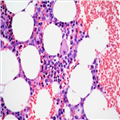Abstract and Introduction
Abstract
Introduction Clindamycin is used to treat various bacterial infections, but its administration can cause anaphylaxis, liver reactions, pseudomembranous colitis, and peripheral blood cytopenias (anemia, neutropenia, and thrombocytopenia), alone or in combination. We report the case of a patient with a recurrent infection of the tonsils who received clindamycin. Pancytopenia, a previously unreported hematological disorder related to clindamycin use, was observed in conjunction with the infection and clindamycin treatment.
Case presentation One month prior to hospitalization, a 22-year-old man of Hispanic origin had a tonsillar infection and cough and began to have anal pain. These conditions became exacerbated three weeks later, coinciding with a new tonsillar infection, frequent nonproductive cough, and febrile syndrome. He received clindamycin for four days prior to his admission, without improvement. While hospitalized, he was found to have fever, tonsillar abscess, hemorrhoid thrombosis, and anal fissure; the latter was immediately resected under general anesthesia. Before surgery, our patient's blood count showed intense leukoneutropenia and mild thrombocytopenia that increased 12 hours later, along with the establishment of anemia. A bone marrow study showed decreased cell content, micromegakaryocytes, and an interruption of the differentiation of granulocytes and erythroblasts. Post-surgery, our patient received metronidazole, meropenem, and amikacin along with acetaminophen, ketoprofen, omeprazole, and pegfilgrastim, with resulting clinical and hematological improvement.
Conclusion Our experience with this patient establishes that well-documented clinical cases should be the basis for identifying and publicizing unknown or uncommon undesirable effects of drugs. We report that, in some individuals, clindamycin can cause pancytopenia, a complication that in our patient's case was caused by direct injury of his hematopoietic tissue.
Introduction
Clindamycin alters ribosomal function and reversibly inhibits bacterial protein synthesis. It is successfully and safely used to treat infections by various microorganisms.[1] However, several undesirable effects have also been described, such as isolated or combined cytopenias in the peripheral blood.[1–4]
We report the clinical case of a patient who received clindamycin for recurrent infection of his tonsils. Because our patient required intensive treatment for the infection and surgical treatment for simultaneous proctological manifestations, he was hospitalized. Intense leukoneutropenia and mild thrombocytopenia were found preoperatively (Figure 1) and intensified in the immediate postoperative period, when anemia was also found.
Figure 1.
Bone marrow biopsy of iliac crest. Image shows diminished cell content; scarce megakaryocytes, with the sole one observed hypolobulated; and diminution of mature granulocytes and erythroid precursors. Note the relative increase of lymphocytes and plasma cells. Hematoxylin and eosin stain; original magnification × 40.
We present the previously unreported presence of pancytopenia in connection with clindamycin use and we discuss its physiopathogenesis, progression, and treatment. We provide a review of the literature related to blood disorders attributable to clindamycin use.
J Med Case Reports. 2014;8(26) © 2014 BioMed Central, Ltd.











